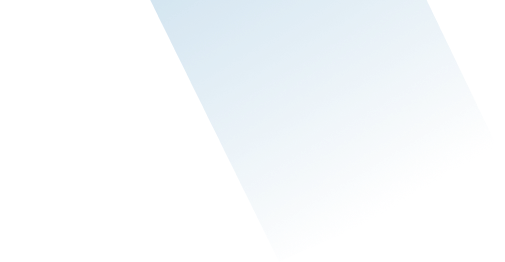Sea Tour
Skerries Sea Tours runs two passenger trips daily; to Rockabill Lighthouse (1 Hour & 15 mins, €35 per person) and Lambay Island (2 Hours, €50 per person). Skerries Sea Tours incorporates a unique and often stunning exploration of the rich bird and wildlife as well as an informative guide to the local history, culture and heritage of the area:
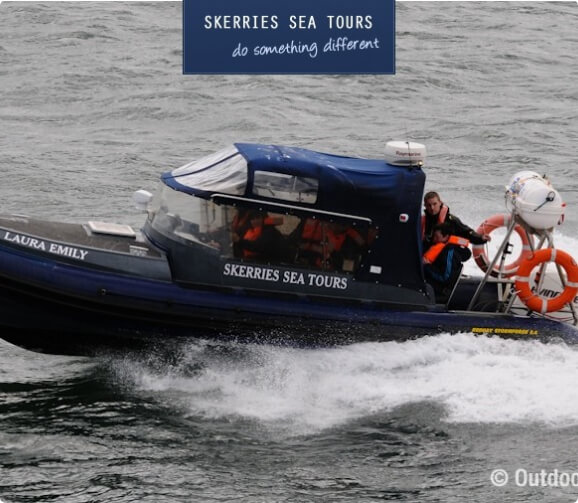
LAMBAY ISLAND ,ROCKABILL LIGHTHOUSE ,SKERRIES ISLANDS
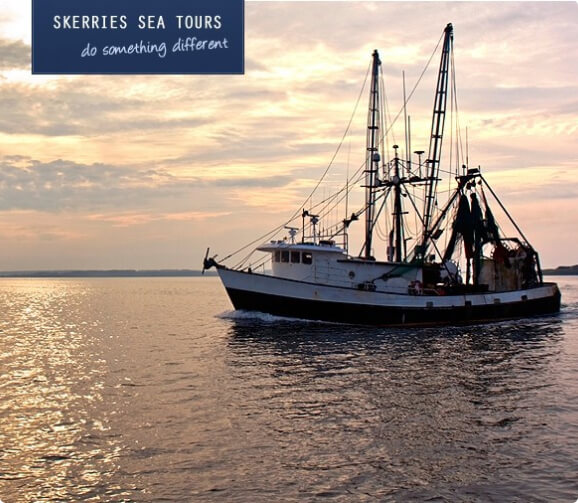
SEATOUR LAMBAY ISLAND
Lambay Island is situated about six miles from Skerries. It is the largest island off the east coast of Ireland and is about 1,371 acres in size. The ancient Greek writers Pliny and Ptolemy knew about the island and referred to it as Limnus or Limni. Implements and other objects from the New Stone Age and early Bronze Age have been found on the island. Gold ornaments from the Iron Age have also been found on the island.
This indicates that Lambay was inhabited at a very early period. Its early Irish name,”Reachra,” was eventually replaced by the Danish Lambay, meaning Lamb Island. This name probably originated with the practice sending over ewes to the island in spring and allowing them to remain there until the Autumn. In early Christian times it was the site of a monastery which was reputed to be the first place on the coast of Ireland to be attacked by the Danes, in the year 795 A.D. Later for some centuries it seems to have been the haunt of pirates. In the 15th century the king of England, who then bore the title of ”Lord of Ireland,” granted the island to the prior of Holmpatrick.
In 1551, after the dissolution of the monasteries it was given to John Challoner and his heirs, provided that he built a village to house the fishermen, a place of refuge for them in case of attack, and a harbour for their boats. Challoner did this. He brought from England a colony of “the king’s subjects” to inhabit the island and make it free from pirates and smugglers. A curious many sided building, raised on arches, with battlements and spike holes, which commands a view in all directions, is still standing on the island. This seems to be the “place of refuge from attack” which was built by Challoner. During the Williamite wars the island was used as an interment camp for Irish soldiers. More then one thousand of them were imprisoned there after the battle of Aughrim in 1691. Early this century a castle was built on Lambay Island with Milverton limestone.
Each stone was shaped from an individual template supplied by the architect, Sir Edwin Luytens. The castle has no right angles. Luytens was a famous English architect and town planner. He planned the principal buildings of New Delhi, in India. At one time there were 62 stone cutters at work on the island as the building progressed. To day the island is a bird sanctuary. It is now owned by Lord Revelstoke. Permission to visit must be obtained from his steward on the island.
Lambay supports the only colony of Grey Seals on the east coast. Although it is a long established breeding site for this species, it remains relatively small (45-60 individuals) probably because of the restricted area suitable for breeding. Grey Seals are listed on Annex II of the EU Habitats Directive. A herd of Fallow Deer (up to c. 80) roams the higher parts of the island, and a small number of wallabies (c. 10).
Lambay Island is internationally important for its breeding seabirds. The most numerous species is the Guillemot, with almost 52,000 individuals on the cliffs. Razorbills (3,646 individuals), Kittiwakes (5,102 individuals), Herring Gulls (2,500 pairs), Cormorants (605 pairs),Shags (1,164 pairs), Puffins (235 pairs), and small numbers of Great and Lesser Black-backed Gulls also breed (all figures from 1995). Between 1991 and 1995 Fulmar numbers varied between 573-737 pairs. There is a small colony (<100 pairs) of the nocturnal Manx Shearwater on the island and up to 20 pairs of Common Terns have bred in recent years. A few Black Guillemots have been recorded on Lambay, but it is not clear if they breed. A pair of Peregrines are known to breed on the island.
Lambay Island is internationally important for its breeding seabirds. The most numerous species is the Guillemot, with almost 52,000 individuals on the cliffs. Razorbills (3,646 individuals), Kittiwakes (5,102 individuals), Herring Gulls (2,500 pairs), Cormorants (605 pairs),Shags (1,164 pairs), Puffins (235 pairs), and small numbers of Great and Lesser Black-backed Gulls also breed (all figures from 1995). Between 1991 and 1995 Fulmar numbers varied between 573-737 pairs. There is a small colony (<100 pairs) of the nocturnal Manx Shearwater on the island and up to 20 pairs of Common Terns have bred in recent years. A few Black Guillemots have been recorded on Lambay, but it is not clear if they breed. A pair of Peregrines are known to breed on the island.
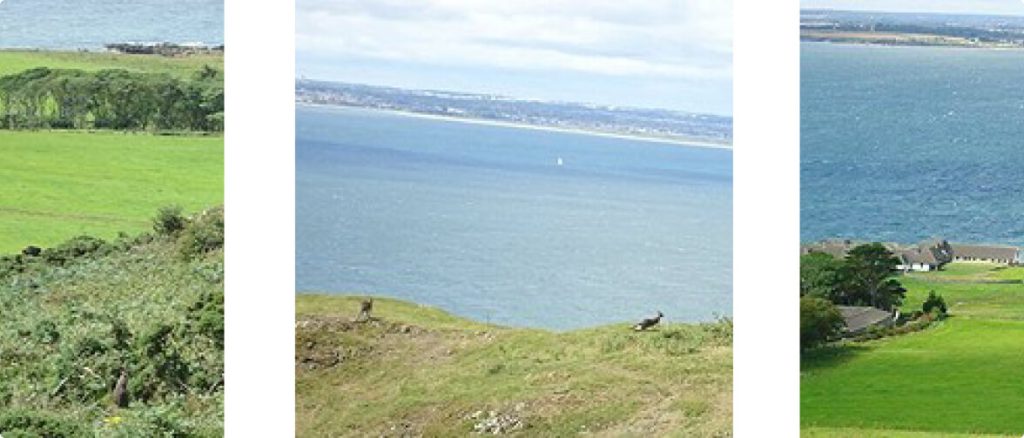
SEATOUR ROCKABILL LIGHTHOUSE
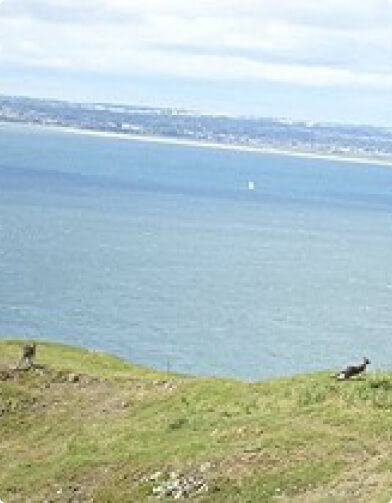
SEATOUR ROCKABILL LIGHTHOUSE
Rockabill lies about five kilometres off the shore in an easterly direction, and is clearly visible from Skerries. The name comes from the Irish name for the rock – Carraig Dá Bheola, meaning “Two Lips Rock”. The depth of the sea around Rockabill is between 7 and 9 fathoms, and the rock was obviously a danger to shipping, especially at night. A light was sought for the rock by the Drogheda Harbour Commissioners in 1837, and they stated that the shipping which frequented Drogheda would cheerfully pay a toll towards a light on Rockabill. The authority, which controlled the building of lighthouses at that time was called the Trinity Board, and in 1838 they refused to build a lighthouse on Rockabill. However fifteen years later, in 1853, the Board changed its mind and granted permission. Plans were prepared for the lighthouse, and in 1855 the work began.
The builders were two brothers from Limerick, William and James Burgess. The chief materials used were granite from the Mourne Mountains in Co. Down and limestone from the local quarry in Milverton. The tower was built 83 feet high and the total cost of all the buildings, and apparatus, was £13,248 .The building was completed and the light was first operated on 1st. July 1860. Coal gas, supplied from a gas producing plant on the rock, provided the light until 1905. Throughout those years the lightkeepers had trouble from the gas system, as it regularly suffered damage from storms and corrosion.
From 1905 the light was powered by paraffin until 1980, when it was converted to electricity. A fog signal was established on Rockabill in 1918, and a radio telephone was installed in 1952. The lighthouse was relieved by a local boat from Skerries, or by one of the vessels owned by the Trinity Board, until 1970. From then it was relieved by helicopter. There were a total of six lightkeepers doing duty on the rock. Three were stationed on the rock doing four weeks duty at a time, while the other three had four weeks liberty. The keepers and their families lived in houses specially built for them in Harbour Road. These houses were sold in 1975, and sadly the lighthouse became fully automatic, and was demanned in March 1989.
Rockabill is an internationally important breeding site for Roseate Tern and is the most important colony in Europe.
In 2000, 614 pairs bred, an increase from 366 in 1991. Common Terns also breed with 607 pairs and 88 pairs of Arctic Tern. Other breeding seabirds are Black Guillemot (36 pairs) and Kittiwakes (160 pairs). Egg predation by Turnstones and probably Gulls was more noticeable than in previous years, but is seems like the Roseate have fared better than the Common and Arctic Terns, with 1.43 young successfully fledged from each egg laying pair. Nest boxes are provided by Eugene Macken’s class in Balbriggan Community College.
Since 1989 the site has been wardened by NPWS and BWI during the breeding season, and research and habitat management have been carried out. The site is owned by the Commissioners of Irish Lights and is a Refuge for Fauna and a Special Protection Area under the EU Birds Directive.
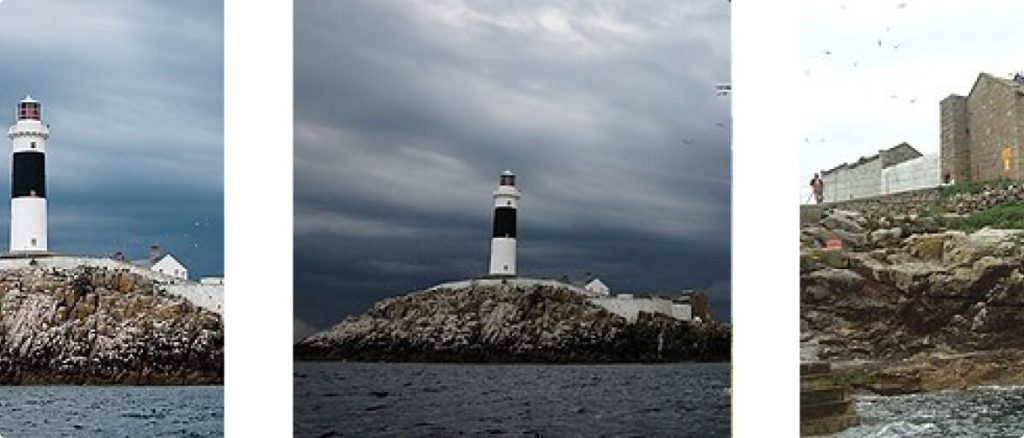
SEATOUR LAMBAY ISLAND
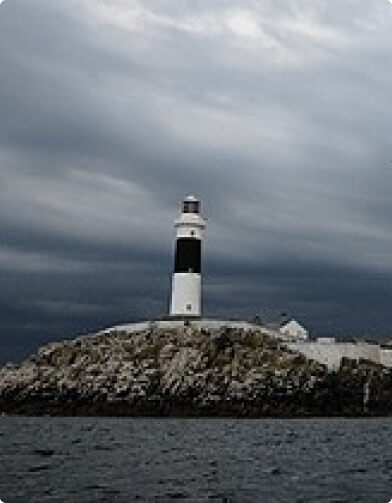
SEATOUR SKERRIES ISLANDS
